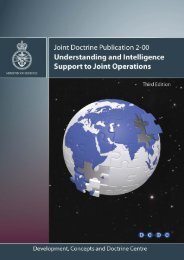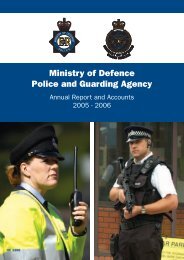Create successful ePaper yourself
Turn your PDF publications into a flip-book with our unique Google optimized e-Paper software.
<strong>LEAFLET</strong> <strong>18</strong><br />
<strong>PERMIT</strong> <strong>TO</strong> <strong>WORK</strong>
MOD Health and Safety Handbook JSP 375 Vol 2<br />
AMENDMENT RECORD<br />
Amend Date Text Affected Authority and<br />
No<br />
Date<br />
01 11/05/10 Scope modified and reference DBR SSDC<br />
to JSP 482 chapter <strong>18</strong> added Safety 3<br />
to related documents<br />
11/05/10<br />
REVISION NOTE<br />
HIS<strong>TO</strong>RICAL RECORD<br />
Original Leaflet was introduced in October 2001.<br />
Revised April 2010.<br />
April 2010 Leaflet <strong>18</strong><br />
Page 2 of 12
MOD Health and Safety Handbook JSP 375 Vol 2<br />
Contents<br />
FOREWORD<br />
<strong>LEAFLET</strong> <strong>18</strong><br />
<strong>PERMIT</strong> <strong>TO</strong> <strong>WORK</strong><br />
1. Scope<br />
2. Introduction<br />
3. When should a Permit to Work be used?<br />
4. Roles and Responsibilities<br />
5. Records<br />
6. Related Documents<br />
Annexes:<br />
A. Permit to Work (template)<br />
B. Register of Permits to Work<br />
C. Is a Permit to Work Required - flowchart<br />
FOREWORD<br />
This leaflet is published under the authority of the Chairman of the Defence<br />
Occupational Health and Safety Board (OHSB). This leaflet is for application<br />
across all areas of MOD and the Armed Forces and reflects any recent<br />
changes in legislation and or MOD practices.<br />
1. SCOPE<br />
1.1 This leaflet provides guidance on the use of Permits to Work (PTW) to<br />
manage the risks arising from hazardous activities on MOD Establishments,<br />
vessels, aircraft, and land vehicles etc. for activities where high level of risk<br />
remain and which are not already covered by a Permit to Work procedure in<br />
JSP 375 Volume 3, Volume 2 Leaflet 34 (4C System - The Management of<br />
Visiting Workers and Contractors) or any other JSP.<br />
1.2 The implementation of JSP 375 Volume 3 is mandatory and therefore<br />
Permits to Work required in Volume 3 take primacy over the guidance<br />
contained in this leaflet.<br />
2. INTRODUCTION<br />
2.1 The MOD has a statutory duty, to provide and maintain plant and<br />
systems of work that are, so far as is reasonably practicable, safe and without<br />
risk to health; for high-risk activities, this may involve setting up a PTW<br />
system. The harmonisation of PTW systems between different locations will<br />
April 2010 Leaflet <strong>18</strong><br />
Page 3 of 12
MOD Health and Safety Handbook JSP 375 Vol 2<br />
provide a familiar format and assist personnel moving between locations to<br />
understand the required controls and procedures to manage high risk<br />
activities. It is therefore recommended that all new PTW systems or the<br />
revision/review of existing PTWs use the guidance and templates contained<br />
within this leaflet.<br />
2.2 A PTW is an effective means of controlling hazardous work activities<br />
and is a legal requirement; is a formal written authority to a named competent<br />
person to closely control an activity or process, to which, following a risk<br />
assessment and the formulation of a safe system of work or a method<br />
statement, a high level of risk still exists. A PTW is the formalisation of a safe<br />
system of work but is not a guarantee of absolute safety.<br />
3. WHEN SHOULD A <strong>PERMIT</strong> <strong>TO</strong> <strong>WORK</strong> BE USED?<br />
3.1 A PTW shall be used whenever it is intended to carry out any work<br />
which may adversely affect the safety of personnel, the environment or plant<br />
and equipment where assessment and the existing safe system of work do<br />
not fully mitigate the level of risk. A PTW is normally used as one of many<br />
control measures for activities such as maintenance work.<br />
3.2 It is also advisable to use PTWs when two or more individuals or<br />
groups of people, perhaps from different trades or different contractors, need<br />
to co-ordinate their activities to ensure that they do not compromise the safety<br />
of each other; each will be issued with a permit. This will apply equally when<br />
there is a transfer of work and responsibilities from one group to another.<br />
4. ROLES AND RESPONSIBILITIES<br />
4.1 Commanding Officer/Head of Establishment (CO/HoE)<br />
4.1.1 The CO/HoE is responsible for the appointment of Sanctioning Officers<br />
(SO) and must satisfy themselves that the SO is competent and has sufficient<br />
knowledge and experience of the task, hazards and potential risks involved<br />
with the activity to evaluate and sanction the PTW on their behalf. The SO<br />
shall be issued with a letter of authority or Terms of Reference (<strong>TO</strong>Rs)<br />
defining the types of PTW that they are authorised to sanction. A process<br />
shall be put in place to ensure that no more than one SO shall be on duty in<br />
any one shift to sanction each type of PTW.<br />
4.2 Line Manager (LM)<br />
4.2.1 The LM (owner of the task) is responsible for ensuring that a risk<br />
assessment has been undertaken prior to requesting a PTW to be raised and<br />
that a suitable safe system of work/method statement has been drafted by a<br />
competent person (seeking specialist advice if necessary). The LM shall<br />
ensure that all controls measures have been implemented and that when the<br />
PTW is issued that they are confident that the risks are as low as is<br />
April 2010 Leaflet <strong>18</strong><br />
Page 4 of 12
MOD Health and Safety Handbook JSP 375 Vol 2<br />
reasonably practicable (ALARP) and acceptable for the work to commence on<br />
the designated task, area or plant for the time specified.<br />
4.3 Sanctioning Officer (SO)<br />
4.3.1 The SO shall have suitable knowledge, experience and the authority to<br />
take action (e.g. refuse to issue, withdraw, or close a PTW) as necessary.<br />
Before issuing the permit, the SO is to be satisfied that suitable risk<br />
assessments and safe systems of work etc. have been developed and all<br />
necessary precautions have been taken, and in conjunction with the Line<br />
Manager, that any work activities that may interact are identified and deconflicted.<br />
The PTW shall only be valid when signed by the SO giving their<br />
authority to proceed (section 5 of the permit at annex A) and must be signed<br />
off by the SO when the activity has been completed or work ceased (section 8<br />
of the permit at annex A).<br />
NOTE: THE SANCTIONING OFFICER IS THE ONLY PERSON WHO<br />
IS AUTHORISED <strong>TO</strong> SIGN FOR AUTHORITY <strong>TO</strong> PROCEED AND<br />
THE SANCTIONING OFFICER’S DECLARATION (PARTS 5 & 8 ON<br />
ANNEX A).<br />
4.3.2 The SO shall periodically monitor PTW tasks to ensure that the<br />
conditions of PTWs are complied with.<br />
4.4 Person in Charge (Supervisor)<br />
4.4.1 The PTW will be issued to the person in charge (PiC), who must be<br />
competent, understand and agree to the conditions of the permit. Such<br />
persons could be employees and or contractors - the same standards of<br />
competency and understanding will apply. The PiC will be the person who<br />
physically supervises the task/activity and shall accept the responsibility for<br />
ensuring compliance with the requirements of the PTW by signing a<br />
declaration (section 6 of the permit at annex A). They are responsible for<br />
directly controlling the task as detailed on the PTW and must always be<br />
present at the location where the activity is being carried out and able to<br />
provide close supervision for the duration of that activity.<br />
4.4.2 The PiC must ensure that they are fully conversant with, and able to<br />
ensure compliance with the conditions set out in the PTW and all<br />
documentation associated with the task, that the PTW is displayed at the point<br />
of work, and that all members of the team are fully briefed, competent and<br />
adequately trained to carry out the task.<br />
4.4.3 The PiC shall ensure that any additional actions required by the PTW<br />
are in place including additional emergency arrangements and that all<br />
necessary safety and emergency equipment is available, suitable and safe for<br />
use before commencing the task and that only the task detailed on the PTW is<br />
carried out. If the conditions of the PTW cannot be met work must stop<br />
immediately and all personnel withdrawn, and when safe to do so, all tools,<br />
plant and equipment and the area made safe.<br />
April 2010 Leaflet <strong>18</strong><br />
Page 5 of 12
MOD Health and Safety Handbook JSP 375 Vol 2<br />
4.4.4 If the PiC leaves the point of work, the task must be stopped and the<br />
area made safe until they return.<br />
4.4.4 The PiC will ensure that “others” directly affected by the activities of the<br />
PTW have been briefed to ensure they are aware of the hazards and control<br />
measures and are subsequently kept informed of any changes of the task.<br />
4.4.5 If the task is not completed within the specified working time, the task<br />
must be stopped, the area made safe and the permit closed. A new permit<br />
shall be raised and issued to the next PiC taking over the responsibility for the<br />
task when work is to resume as the permit is issued to the individual PiC not<br />
the task.<br />
NOTE: UNDER NO CIRCUMSTANCES CAN THE SAME PERSON<br />
CARRY OUT THE DUTIES OF THE SANCTIONING OFFICER AND BE<br />
THE PERSON IN CHARGE OF THE TASK/ACTIVITY. (PARTS 5, 6 &<br />
8 OF ANNEX A)<br />
5. RECORDS<br />
5.1 Ships/Units/Establishments where a PTW system is in place shall<br />
maintain a register of PTWs (example template at Annex B). Completed<br />
PTWs and Registers are to be retained as follows:<br />
5.2 The Register of PTWs is to be retained for a minimum of three years<br />
following the last entry.<br />
5.3 The original signed copy (working copy) of the PTW is to be issued to<br />
the PiC and a copy retained by the SO for the duration of the task. Upon<br />
completion of the task the original (working copy) will be returned to the SO<br />
who will complete and signed off the PTW. The original (working copy) will be<br />
filed together with any associated unique supporting documentation and<br />
retained for a minimum of three years.<br />
6. RELATED DOCUMENTS<br />
6.1 The following documents should be consulted in conjunction with this<br />
leaflet:<br />
JSP 375:<br />
a. Volume 2, Leaflet 39 – Health and Safety Risk Assessment<br />
b. Volume 3, Chapters 2 to 8<br />
JSP 482:<br />
a. Part 3 Operating & Management, Chapter <strong>18</strong><br />
April 2010 Leaflet <strong>18</strong><br />
Page 6 of 12
MOD Health and Safety Handbook JSP Vol 2<br />
MOD Form 5071<br />
ANNEX A<br />
Permit to work<br />
Permit Serial No:……………………………… Date………………….<br />
PART 1 - GENERAL<br />
Ship/Unit/Establishment<br />
Location of person responsible for the<br />
task<br />
Location of the task<br />
Activity<br />
Validity of PTW<br />
(to be completed by the Sanctioning<br />
Officer)<br />
PART 2 -TASK <strong>TO</strong> BE CARRIED OUT<br />
From: : hrs on (date)<br />
To: : hrs on (date)<br />
Description of the equipment or system and activity or tasks to be carried out:<br />
PART 3 - CROSS-REFERENCED DOCUMENTATION<br />
List all associated Risk assessments, PTWs, Safe Systems of Work, Method statements, or<br />
Maintenance procedures.<br />
PART 4 – HAZARD IDENTIFICATION AND CONTROL MEASURES<br />
The following residual hazards exist or have been introduced to this task and the listed<br />
control measures are to be implemented (include PPE requirements).<br />
Hazard:<br />
Control measure:<br />
PART 5 – AUTHORITY <strong>TO</strong> PROCEED BY SANCTIONING OFFICER<br />
I have reviewed all aspects of the task/activity and am satisfied with the arrangements as<br />
detailed in the “Safe System / Method Statement” have been put in place and certify that<br />
the activity/process detailed at Part 2 is authorised to proceed.<br />
Signed ________________________ Name<br />
Rank/Grade Appointment Date Time<br />
Feb 2009 Leaflet <strong>18</strong> Annex A<br />
Page 7 of 12
MOD Health and Safety Handbook JSP Vol 2<br />
MOD Form 5071<br />
ANNEX A<br />
PART 6 – TASK ACCEPTANCE BY THE PERSON IN CHARGE<br />
I certify that I am competent to carry out the person in charge function and have read and<br />
fully understand the documentation associated with the task and listed at Part 3. I am<br />
satisfied that those personnel who will be employed on the task are properly equipped and<br />
understand the safety and emergency procedures to be followed and are competent to<br />
carry out the task.<br />
Signed _________________________ Name ____________________________<br />
Rank/Grade ___________ Appointment __________ Date _______ Time _______<br />
PART 7 - TASK COMPLETION/TASK S<strong>TO</strong>PPED BY THE PERSON IN CHARGE<br />
I certify that the task/activity detailed at part 2 has been:- (* delete as applicable)<br />
*a. Completed<br />
*b. stopped/suspended. The task was stopped/suspended at___:___hrs on the<br />
______(date). Details of the reasons for stoppage/suspension are detailed at part 9<br />
complete with details of what arrangements have been put in place to make safe and<br />
isolate and prevent all unauthorised access to the activity/process.<br />
Signed _____________________________ Name ___________________________<br />
Rank/Grade ___________ Appointment _________ Date _______ Time _______<br />
PART 8 – SANCTIONING OFFICER’S DECLARATION<br />
I certified that this permit to work is cancelled and that the task/activity detailed at part 2<br />
has been:- (* delete as applicable)<br />
*a. Completed at___:___hrs on the______(date).<br />
*b. Stopped/Suspended. I concur that the task was stopped/suspended for the reasons<br />
detailed at part 9 and agree with the arrangements that have been put in place to prevent<br />
unauthorised access. This permit to work is now cancelled and all further work will be<br />
authorised on Permit to<br />
Work serial No ___________________<br />
Signed _____________________________ Name ___________________________<br />
Rank/Grade ___________ Appointment _________ Date _______ Time _______<br />
Feb 2009 Leaflet <strong>18</strong> Annex A<br />
Page 8 of 12
MOD Health and Safety Handbook JSP Vol 2<br />
MOD Form 5071<br />
ANNEX A<br />
Permit to work<br />
Permit Serial No:……………………………… Date………………….<br />
PART 9 – <strong>WORK</strong> S<strong>TO</strong>PPED/SUSPENDED BY PERSON IN CHARGE<br />
a. The task detailed at Part 2 has been stopped/suspended for the reasons listed :<br />
b. The following arrangements have been put in place to make safe and prevent<br />
unauthorised access to the work area, and interested parties notified of any safetyrelated<br />
implications of the work stopping e.g. electrical supplies or other services<br />
remaining isolated:<br />
Certified by the person in charge.<br />
Signed: ___________________________ Name: ____________________________<br />
Rank/Grade: ____________ Appointment: ________________________________<br />
Date: ___________ Time: ___________<br />
Feb 2009 Leaflet <strong>18</strong> Annex A<br />
Page 9 of 12
MOD Health and Safety Handbook JSP Vol 2<br />
MOD Form 5071<br />
ANNEX A<br />
DRAWING / SKETCH<br />
Feb 2009 Leaflet <strong>18</strong> Annex A<br />
Page 10 of 12
Ship/Unit/Establishment<br />
Work Area or Function<br />
MOD Health and Safety Handbook JSP Vol 2<br />
MOD Form 5072<br />
ANNEX B<br />
<strong>PERMIT</strong> <strong>TO</strong> <strong>WORK</strong><br />
REGISTER OF <strong>PERMIT</strong>S <strong>TO</strong> <strong>WORK</strong><br />
Serial No of Permit Type of Permit Date and Time<br />
Permit Issued<br />
Date and Time<br />
Permit Closed<br />
Sanctioning Officer Person in Charge<br />
Feb 2009 Leaflet <strong>18</strong> Annex B<br />
Page 11 of 12
MOD Health and Safety Handbook JSP Vol 2<br />
ANNEX C<br />
No<br />
Carry out a<br />
Risk<br />
Assessment<br />
IS A <strong>PERMIT</strong> <strong>TO</strong> <strong>WORK</strong> REQUIRED?<br />
FLOWCHART<br />
Yes<br />
Do significant risks still exist<br />
after control measures have<br />
been implemented?<br />
Yes<br />
Does a documented safe<br />
system / method statement<br />
etc. exist?<br />
No Yes<br />
Formulate a written<br />
safe system of<br />
work/method<br />
statement to control<br />
the risks that still<br />
exist<br />
Has a Risk Assessment for the<br />
Process / Activity been carried<br />
out?<br />
Do significant risks still exist<br />
following the formulation of a<br />
safe system/method statement<br />
or does the safe<br />
system/method statement<br />
require further control<br />
measures?<br />
Yes<br />
Permit to work required<br />
No<br />
No<br />
Permit to work not<br />
required<br />
Feb 2009 Leaflet <strong>18</strong> Annex C<br />
Page 12 of 12



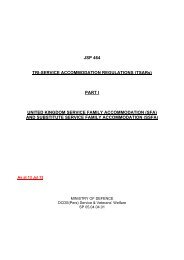
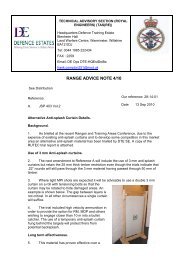

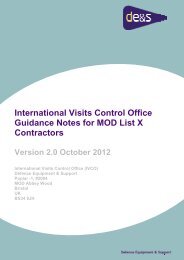

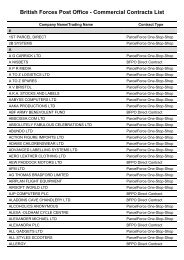

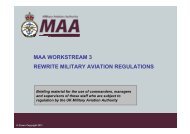

![MAA Regulatory Publications - FAQs PDF [37.3 KB]](https://img.yumpu.com/5906104/1/184x260/maa-regulatory-publications-faqs-pdf-373-kb.jpg?quality=85)
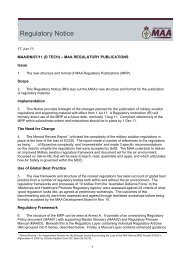
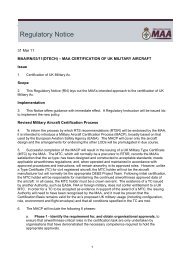
![3750 edition 6 PDF [263.5 KB] - Ministry of Defence](https://img.yumpu.com/5901071/1/184x260/3750-edition-6-pdf-2635-kb-ministry-of-defence.jpg?quality=85)
